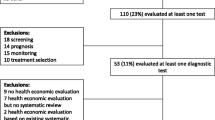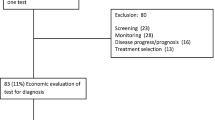Abstract
Diagnostic tests are used to determine whether a disease or condition is present or absent in a patient, who will typically be suspected of having the disease or condition due to symptoms or clinical signs. Economic evaluations of diagnostic tests (e.g. cost-effectiveness analyses) can be used to determine whether a test produces sufficient benefit to justify its cost. Evidence on the benefits conferred by a test is often restricted to its accuracy, which means mathematical models are required to estimate the impact of a test on outcomes that matter to patients and health payers. It is important to realise the case for introducing a new test may not be restricted to its accuracy, but extend to factors such as time to diagnosis and acceptability for patients. These and other considerations may mean the common modelling approach, the decision tree, is inappropriate for underpinning an economic evaluation. There are no consensus guidelines on how economic evaluations of diagnostic tests should be conducted—this article attempts to explore the common challenges encountered in economic evaluations, suggests solutions to those challenges, and identifies some areas where further methodological work may be necessary.






Similar content being viewed by others
References
Ferrante di Ruffano L, Davenport C, Eisinga A, Hyde C, Deeks JJ. A capture-recapture analysis demonstrated that randomized controlled trials evaluating the impact of diagnostic tests on patient outcomes are rare. J Clin Epidemiol. 2012;65:282–7.
Ferrante di Ruffano L, Harris IM, Zhelev Z, Davenport C, Mallett S, Peters J, et al. Health technology assessment of diagnostic tests: a state of the art review of methods guidance from international organisations. medRxiv. 2022;31:154.
Chen G, Peirce V, Marsh W. Evaluation of the National Institute for Health and Care Excellence Diagnostics Assessment Program decisions: incremental cost-effectiveness ratio thresholds and decision-modifying factors. Value in Health. 2020;23:1300–6.
van der Pol S, Rojas Garcia P, Antoñanzas Villar F, Postma MJ, van Asselt ADI. Health-economic analyses of diagnostics: guidance on design and reporting. Pharmacoeconomics. 2021;39:1355–63.
Husereau D, Drummond M, Augustovski F, de Bekker-Grob E, Briggs AH, Carswell C, et al. Consolidated health economic evaluation reporting standards (CHEERS) 2022 explanation and elaboration: a report of the ISPOR CHEERS II good practices task force. Value in Health. 2022;25:10–31.
Novielli N, Cooper NJ, Sutton AJ. Evaluating the cost-effectiveness of diagnostic tests in combination: is it important to allow for performance dependency? Value Health. 2013;16:536–41.
Novielli N, Sutton AJ, Cooper NJ. Meta-analysis of the accuracy of two diagnostic tests used in combination: application to the Ddimer test and the Wells score for the diagnosis of deep vein thrombosis. Value Health. 2013;16:619–28.
Fassbender K, Walter S, Grunwald IQ, Merzou F, Mathur S, Lesmeister M, et al. Prehospital stroke management in the thrombectomy era. Lancet Neurol. 2020;19:601–10.
Erenay FS, Alagoz O, Banerjee R, Said A, Cima RR. Cost-effectiveness of alternative colonoscopy surveillance strategies to mitigate metachronous colorectal cancer incidence. Cancer. 2016;122:2560–70.
Snowsill TM, Ryan NA, Crosbie EJ. Cost-effectiveness of the Manchester approach to identifying Lynch syndrome in women with endometrial cancer. J Clin Med. 2020;9:1664.
Ferrante di Ruffano L, Hyde CJ, McCaffery KJ, Bossuyt PM, Deeks JJ. Assessing the value of diagnostic tests: a framework for designing and evaluating trials. BMJ. 2012;344:e686.
Cocco P, Ayaz-Shah A, Messenger MP, West RM, Shinkins B. Target Product Profiles for medical tests: a systematic review of current methods. BMC Med. 2020;18:119.
Huxley N, Jones-Hughes T, Coelho H, Snowsill T, Cooper C, Meng Y, et al. A systematic review and economic evaluation of intraoperative tests [RD-100i one-step nucleic acid amplification (OSNA) system and Metasin test] for detecting sentinel lymph node metastases in breast cancer. Health Technol Assess. 2015;19:216.
Wright DR, Wittenberg E, Swan JS, Miksad RA, Prosser LA. Methods for measuring temporary health states for cost-utility analyses. Pharmacoeconomics. 2009;27:713–23.
Ogwulu CB, Jackson LJ, Kinghorn P, Roberts TE. A systematic review of the techniques used to value temporary health states. Value in Health. 2017;20:1180–97.
Stoniute J, Mott DJ, Shen J. Challenges in valuing temporary health states for economic evaluation: a review of empirical applications of the chained time trade-off method. Value in Health. 2018;21:605–11.
Purba FD, Hunfeld JAM, Iskandarsyah A, Fitriana TS, Sadarjoen SS, Ramos-Goñi JM, et al. The Indonesian EQ-5D-5L value set. Pharmacoeconomics. 2017;35:1153–65.
Craig BM, Rand K, Bailey H, Stalmeier PFM. Quality-adjusted life-years without constant proportionality. Value in Health. 2018;21:1124–31.
Bala MV, Zarkin GA. Are QALYs an appropriate measure for valuing morbidity in acute diseases? Health Econ. 2000;9:177–80.
Franic DM, Pathak DS, Gafni A. Quality-adjusted life years was a poor predictor of women’s willingness to pay in acute and chronic conditions: results of a survey. J Clin Epidemiol. 2005;58:291–303.
Neumann PJ, Cohen JT, Hammitt JK, Concannon TW, Auerbach HR, Fang C, et al. Willingness-to-pay for predictive tests with no immediate treatment implications: a survey of US residents. Health Econ. 2012;21:238–51.
Deeks J, Bossuyt P, Gatsonis C, editors. Cochrane handbook for systematic reviews of diagnostic test accuracy [Internet]. The Cochrane Collaboration; 2013. http://srdta.cochrane.org/.
Bojke L, Soares MO, Claxton K, Colson A, Fox A, Jackson C, et al. Reference case methods for expert elicitation in health care decision making. Med Decis Making. 2022;42:182–93.
Sassi F, McKee M, Roberts JA. Economic evaluation of diagnostic technology: methodological challenges and viable solutions. Int J Technol Assess Health Care. 1997;13:613–30.
Gigerenzer G, Gaissmaier W, Kurz-Milcke E, Schwartz LM, Woloshin S. Helping doctors and patients make sense of health statistics. Psychol Sci Public Interest. 2007;8:53–96.
Sutton AJ, Cooper NJ, Goodacre S, Stevenson M. Integration of meta-analysis and economic decision modeling for evaluating diagnostic tests. Med Decis Making. 2008;28:650–67.
Varley-Campbell J, Mújica-Mota R, Coelho H, Ocean N, Barnish M, Packman D, et al. Three biomarker tests to help diagnose preterm labour: a systematic review and economic evaluation. Health Technol Assess. 2019;23:1–226.
Soares MO, Walker S, Palmer SJ, Sculpher MJ. Establishing the value of diagnostic and prognostic tests in health technology assessment. Med Decis Making. 2018;38:495–508.
Haji Ali Afzali H, Bojke L, Karnon J. Model structuring for economic evaluations of new health technologies. Pharmacoeconomics. 2018;36:1309–19.
Roberts M, Russell LB, Paltiel AD, Chambers M, McEwan P, Krahn M. Conceptualizing a model: a report of the ISPOR-SMDM modeling good research practices task force-2. Med Decis Making. 2012;32:678–89.
van Smeden M, Naaktgeboren CA, Reitsma JB, Moons KGM, de Groot JAH. Latent class models in diagnostic studies when there is no reference standard—a systematic review. Am J Epidemiol. 2013;179:423–31.
Alba AC, Agoritsas T, Walsh M, Hanna S, Iorio A, Devereaux PJ, et al. Discrimination and calibration of clinical prediction models: users’ guides to the medical literature. JAMA. 2017;318:1377–84.
Edwards SJ, Mavranezouli I, Osei-Assibey G, Marceniuk G, Wakefield V, Karner C. VivaScope 1500 and 3000 systems for detecting and monitoring skin lesions: a systematic review and economic evaluation. Health Technol Assess. 2016;20:1–260.
Ferrante di Ruffano L, Dinnes J, Sitch AJ, Hyde C, Deeks JJ. Test-treatment RCTs are susceptible to bias: a review of the methodological quality of randomized trials that evaluate diagnostic tests. BMC Med Res Methodol. 2017;17:1–12.
Hot A, Bossuyt PM, Gerke O, Wahl S, Vach W, Zapf A. Randomized test-treatment studies with an outlook on adaptive designs. BMC Med Res Methodol. 2021;21:1–12.
Acknowledgements
I thank Prof. Chris Hyde (University of Exeter) for reviewing a draft of this manuscript, which prompted valuable discussion.
Author information
Authors and Affiliations
Corresponding author
Ethics declarations
Funding
None.
Conflicts of interest/competing interest
The author declares no conflict of interest.
Ethical approval
Not applicable.
Consent to publish
Not applicable.
Consent to participate
Not applicable.
Author contributions
TS is the sole author.
Data availability
There are no data included in this article that are not in the public domain. The simulated example shown in Fig. 2 can be replicated by drawing \(\left({X}_{1},{X}_{2}\right)\) from a bivariate normal distribution with mean \(\left(\mathrm{0,0}\right)\) and covariance matrix \(\left(\begin{array}{cc}1& 0.4\\ 0.4& 1\end{array}\right)\), then simulating \({Z}_{1}\sim \mathcal{N}\left({X}_{1},0.2\right),{Z}_{2}\sim \mathcal{N}\left({X}_{1},0.2\right)\) and \({Z}_{3}\sim \mathcal{N}\left({X}_{2},0.2\right)\), and finally simulating the test results as \({Y}_{1}=I\left({Z}_{1}>0.6\right)\), \({Y}_{2}=I\left({Z}_{2}>0\right)\) and \({Y}_{3}=I\left({Z}_{3}>0.5\right)\). The true disease status is given by \(I\left({X}_{1}+{X}_{2}>1\right)\).
Supplementary Information
Below is the link to the electronic supplementary material.
40273_2023_1241_MOESM1_ESM.xlsx
Electronic Supplementary Material: Example decision tree implemented in Excel showing the importance of accounting for heterogeneity in pre-test probability. (XLSX 111 KB)
Rights and permissions
Springer Nature or its licensor (e.g. a society or other partner) holds exclusive rights to this article under a publishing agreement with the author(s) or other rightsholder(s); author self-archiving of the accepted manuscript version of this article is solely governed by the terms of such publishing agreement and applicable law.
About this article
Cite this article
Snowsill, T. Modelling the Cost-Effectiveness of Diagnostic Tests. PharmacoEconomics 41, 339–351 (2023). https://doi.org/10.1007/s40273-023-01241-2
Accepted:
Published:
Issue Date:
DOI: https://doi.org/10.1007/s40273-023-01241-2




